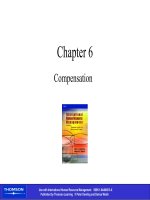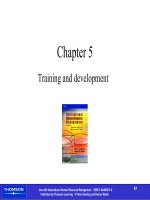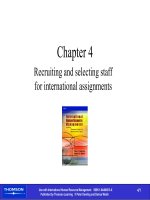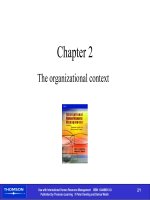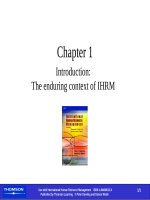International human resource management - Chapter 3 ppt
Bạn đang xem bản rút gọn của tài liệu. Xem và tải ngay bản đầy đủ của tài liệu tại đây (959.99 KB, 25 trang )
1
Use with International Human Resource Management ISBN 1-84480013-X
Published by Thomson Learning © Peter Dowling and Denice Welch
3/1
Chapter 3
IHRM: Sustaining international
business operations
2
Use with International Human Resource Management ISBN 1-84480013-X
Published by Thomson Learning © Peter Dowling and Denice Welch
3/2
Chapter objectives
•
issues relating to the various approaches to staffing foreign operations
•
the reasons for using international assignments: position filling,
management development and organizational development
(cont.)
The previous two chapters concentrated on the global
environment and organizational contexts. We now focus on
the ‘managing people’ aspect. The aim is to establish the role
of HRM in sustaining international business operations and
growth. We cover the following:
3
Use with International Human Resource Management ISBN 1-84480013-X
Published by Thomson Learning © Peter Dowling and Denice Welch
3/3
Chapter objectives (cont.)
•
the various types of international assignments: short-term,
extended and longer-term; and non-standard arrangements:
commuter, rotator, contractual and virtual
•
the role of expatriates and non-expatriates (international
business travelers) in supporting international business
activities
•
the role of the corporate HR function.
4
Use with International Human Resource Management ISBN 1-84480013-X
Published by Thomson Learning © Peter Dowling and Denice Welch
3/4
Approaches to staffing
•
Factors affecting approaches to staffing
–
General staffing policy on key positions at
headquarters and subsidiaries
•
Ethnocentric
•
Polycentric
•
Geocentric
•
Regiocentric
–
Constraints placed by host government
–
Staff availability
5
Use with International Human Resource Management ISBN 1-84480013-X
Published by Thomson Learning © Peter Dowling and Denice Welch
3/5
Ethnocentric
•
Strategic decisions are made at headquarters
•
Limited subsidiary autonomy
•
Key positions in domestic and foreign
operations are held by headquarters’
personnel; PCNs manage subsidiaries
6
Use with International Human Resource Management ISBN 1-84480013-X
Published by Thomson Learning © Peter Dowling and Denice Welch
3/6
Polycentric
•
Each subsidiary is a distinct national entity
with some decision-making autonomy
•
HCNs manage subsidiaries who are seldom
promoted to HQ positions
•
PCNs rarely transferred to subsidiary
positions
7
Use with International Human Resource Management ISBN 1-84480013-X
Published by Thomson Learning © Peter Dowling and Denice Welch
3/7
Geocentric
•
A global approach - worldwide integration
•
View that each part of the organization
makes a unique contribution
•
Nationality ignored in favour of ability:
–
Best person for the job
–
Colour of passport does not matter when it
comes to rewards, promotion and development
8
Use with International Human Resource Management ISBN 1-84480013-X
Published by Thomson Learning © Peter Dowling and Denice Welch
3/8
Figure 3-1: Geocentric staffing requirements
9
Use with International Human Resource Management ISBN 1-84480013-X
Published by Thomson Learning © Peter Dowling and Denice Welch
3/9
Regiocentric
•
Reflects a regional strategy and structure
•
Regional autonomy in decision making
•
Staff move within the designated region,
rather than globally
–
Staff transfers between regions are rare
10
Use with International Human Resource Management ISBN 1-84480013-X
Published by Thomson Learning © Peter Dowling and Denice Welch
3/10
Table 3-1: The advantages and disadvantages of using
PCNs, TCNs and HCNs
11
Use with International Human Resource Management ISBN 1-84480013-X
Published by Thomson Learning © Peter Dowling and Denice Welch
3/11
Figure 3-2: Determinants of IHRM approaches and activities
12
Use with International Human Resource Management ISBN 1-84480013-X
Published by Thomson Learning © Peter Dowling and Denice Welch
3/12
Reasons for international
assignments
•
Position filling
–
Eg. Skills gap, launch of new endeavour, technology
transfer
•
Management development
–
Training and development purposes, assisting in
developing common corporate values
•
Organizational development
–
Need for control, transfer of knowledge, competence,
procedures and practices
13
Use with International Human Resource Management ISBN 1-84480013-X
Published by Thomson Learning © Peter Dowling and Denice Welch
3/13
Types of international
assignments
•
Short term
–
Up to 3 months
•
Extended
–
Up to 1 year
•
Long term
–
Varies from 1 to 5 years
–
The traditional expatriate assignment
14
Use with International Human Resource Management ISBN 1-84480013-X
Published by Thomson Learning © Peter Dowling and Denice Welch
3/14
Non-standard assignments
•
Commuter assignments
•
Rotational assignments
•
Contractual assignments
•
Virtual assignments
Some of these arrangements assist in overcoming the
high cost of international assignments but are not
always effective substitutes for the traditional
expatriate assignment
15
Use with International Human Resource Management ISBN 1-84480013-X
Published by Thomson Learning © Peter Dowling and Denice Welch
3/15
Figure 3-3: Factors influencing virtual assignments
16
Use with International Human Resource Management ISBN 1-84480013-X
Published by Thomson Learning © Peter Dowling and Denice Welch
3/16
Roles of an expatriate
•
Agent of direct control
•
Agent of socialization
•
Network builder
•
Boundary spanner
•
Language node
•
Transfer of competence and knowledge
17
Use with International Human Resource Management ISBN 1-84480013-X
Published by Thomson Learning © Peter Dowling and Denice Welch
3/17
Figure 3-4: The roles of an expatriate
18
Use with International Human Resource Management ISBN 1-84480013-X
Published by Thomson Learning © Peter Dowling and Denice Welch
3/18
The role of non-expatriates
•
People who travel internationally yet are not
considered expatriates as they do not
relocate to another country
–
Road warriors, globetrotters, frequent fliers
•
Much of international business involves
visits to foreign locations, eg.
–
Sales staff attending trade fairs
–
Periodic visits to foreign operations
19
Use with International Human Resource Management ISBN 1-84480013-X
Published by Thomson Learning © Peter Dowling and Denice Welch
3/19
A glamorous life?
•
International business travelers cite the
positives as:
–
Excitement and thrills of conducting business
deals in foreign locations
–
Life style (top hotels, duty-free shopping,
business class travel)
–
General exotic nature
20
Use with International Human Resource Management ISBN 1-84480013-X
Published by Thomson Learning © Peter Dowling and Denice Welch
3/20
But a high level of stress!
•
Home and family issues – frequent absences
•
Work arrangements – domestic side of
position still has to be attended to
•
Travel logistics – waiting in airports, etc.
•
Health concerns – poor diet, lack of sleep,
etc.
•
Host culture issues – limited cultural
training
21
Use with International Human Resource Management ISBN 1-84480013-X
Published by Thomson Learning © Peter Dowling and Denice Welch
3/21
Table 3-2: Various roles of corporate HR
22
Use with International Human Resource Management ISBN 1-84480013-X
Published by Thomson Learning © Peter Dowling and Denice Welch
3/22
The role of the corporate HR
function
•
Can we manage our people like a global
product? The feasibility of:
–
The concept of a global internal labour market
–
Standardization of work practices and HR
activities
•
What HR matters require central control
and what can be decentralized?
23
Use with International Human Resource Management ISBN 1-84480013-X
Published by Thomson Learning © Peter Dowling and Denice Welch
3/23
Chapter summary
•
Looked at the various approaches to staffing international operations –
ethnocentric, polycentric, geocentric and regiocentric – examining their
advantages and disadvantages and factors that may determine the choice
of these options.
•
Considered the reasons for using international assignments: position
filling, management development and organization development.
(cont.)
This chapter has expanded on the role of IHRM in sustaining
international business operations. We have:
24
Use with International Human Resource Management ISBN 1-84480013-X
Published by Thomson Learning © Peter Dowling and Denice Welch
3/24
Chapter summary (cont.)
•
Discussed the various types of international assignments: short, extended and
long-term (traditional); and non-standard forms such as commuter, rotational,
contractual and virtual assignments.
•
Examined the various roles of the expatriate: as an agent for direct control, as
an agent for socialization, as network builders, as boundary spanners and as
language nodes. These various roles of the expatriate help to explain why
expatriates are utilized and illustrates why international assignments continue
to be an important aspect of international business from the organization’s
perspective.
(cont.)
25
Use with International Human Resource Management ISBN 1-84480013-X
Published by Thomson Learning © Peter Dowling and Denice Welch
3/25
Chapter summary (cont.)
•
Recognized that non-expatriates are also critical to international
business operations. International business travelers present their
own challenges, such as the effect of frequent absences on family
and home life, the possible negative health effects and other stress
factors. The management of such individuals, however, does not
appear to fall within the domain of the HR department.
•
Looked at the role of the corporate HR function as the firm grows
internationally, building on sections from Chapters 1 and 2.



